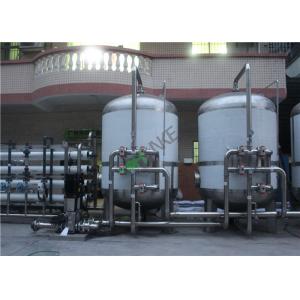45TPH Big Water Desalination Equipment / Reverse Osmosis Water Treatment Plant
Add to Cart

45TPH Big Seawater Desalination Equipment Water Purification Machines
Brief process
Seawater →water tank→ booster pump→ Mechanical filter →Security filter→ High pressure pump → Seawater desalination RO membrane modules → potable water tank
The typical single-pass SWRO system consists of the following components:
- Intake
- Pretreatment
- High pressure pump
- Membrane assembly
- Remineralisation and pH adjustment
- Disinfection
- Alarm/control panel
Pretreatment
Pretreatment is important when working with RO and nanofiltration (NF) membranes due to the nature of their spiral wound design. The material is engineered in such a fashion as to allow only one-way flow through the system. As such, the spiral wound design does not allow for backpulsing with water or air agitation to scour its surface and remove solids. Since accumulated material cannot be removed from the membrane surface systems, they are highly susceptible to fouling (loss of production capacity). Therefore, pretreatment is a necessity for any RO or NF system. Pretreatment in SWRO systems has four major components:
- Screening of solids: Solids within the water must be removed and the water treated to prevent fouling of the membranes by fine particle or biological growth, and reduce the risk of damage to high-pressure pump components.
- Cartridge filtration: Generally, string-wound polypropylene filters are used to remove particles of 1–5 µm diameter.
- Dosing: Oxidizing biocides, such as chlorine, are added to kill bacteria, followed by bisulfite dosing to deactivate the chlorine, which can destroy a thin-film composite membrane. There are also biofouling inhibitors, which do not kill bacteria, but simply prevent them from growing slime on the membrane surface and plant walls.
- Prefiltration pH adjustment: If the pH, hardness and the alkalinity in the feedwater result in a scaling tendency when they are concentrated in the reject stream, acid is dosed to maintain carbonates in their soluble carbonic acid form.
- Carbonic acid cannot combine with calcium to form calcium carbonate scale. Calcium carbonate scaling tendency is estimated using the Langelier saturation index. Adding too much sulfuric acid to control carbonate scales may result in calcium sulfate, barium sulfate or strontium sulfate scale formation on the RO membrane.
- Prefiltration antiscalants: Scale inhibitors (also known as antiscalants) prevent formation of all scales compared to acid, which can only prevent formation of calcium carbonate and calcium phosphate scales. In addition to inhibiting carbonate and phosphate scales, antiscalants inhibit sulfate and fluoride scales, disperse colloids and metal oxides. Despite claims that antiscalants can inhibit silica formation, there is no concrete evidence to prove that silica polymerization can be inhibited by antiscalants. Antiscalants can control acid soluble scales at a fraction of the dosage required to control the same scale using sulfuric acid.
- Some small scale desalination units use Beach wells, they are usually drilled on the seashore in close vicinity to the ocean. These intake facilities are relatively simple to build and the seawater they collect is pretreated via slow filtration through the subsurface sand/seabed formations in the area of source water extraction. Raw seawater collected using beach wells is often of better quality in terms of solids, silt, oil and grease, natural organic contamination and aquatic microorganisms, compared to open seawater intakes. Sometimes, beach intakes may also yield source water of lower salinity.
High pressure pump
The pump supplies the pressure needed to push water through the membrane, even as the membrane rejects the passage of salt through it. Typical pressures for brackish water range from 225 to 375 psi (15.5 to 26 bar, or 1.6 to 2.6 MPa). In the case of seawater, they range from 800 to 1,180 psi (55 to 81.5 bar or 6 to 8 MPa). This requires a large amount of energy.
Membrane assembly
The membrane assembly consists of a pressure vessel with a membrane that allows feedwater to be pressed against it. The membrane must be strong enough to withstand whatever pressure is applied against it. RO membranes are made in a variety of configurations, with the two most common configurations being spiral-wound and hollow-fiber.
Remineralisation and pH adjustment
The desalinated water is very corrosive and is "stabilized" to protect downstream pipelines and storages, usually by adding lime or caustic to prevent corrosion of concrete lined surfaces. Liming material is used to adjust pH between 6.8 and 8.1 to meet the potable water specifications, primarily for effective disinfection and for corrosion control.
Disinfection
Post-treatment consists of preparing the water for distribution after filtration. Reverse osmosis is an effective barrier to pathogens, however post-treatment provides secondary protection against compromised membranes and downstream problems. Disinfection by means of UV lamps (sometimes called germicidal or bactericidal) may be employed to sterilize pathogens which bypassed the reverse osmosis process. Chlorination or chloramination (chlorine and ammonia) protects against pathogens which may have lodged in the distribution system downstream, such as from new construction, backwash, compromised pipes, etc.
This machine is designed of small size, thus is light, convenient for installation and adaptation. It is easyto be operated and maintained.
Detail Pictures :




